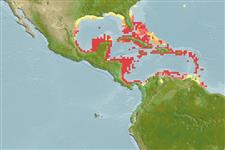>
Eupercaria/misc (Various families in series Eupercaria) >
Scaridae (Parrotfishes) > Sparisomatinae
Etymology: Sparisoma: Latin, sparus = a fish with a golden head + Greek, soma = body (Ref. 45335).
More on author: Valenciennes.
Environment: milieu / climate zone / depth range / distribution range
Ecologia
marinhas associadas(os) a recifes; intervalo de profundidade 2 - 20 m (Ref. 9710). Subtropical; 33°N - 8°N, 98°W - 51°W
Western Atlantic: throughout the Caribbean Sea.
Length at first maturity / Tamanho / Peso / Idade
Maturity: Lm ?, range 15 - ? cm
Max length : 28.0 cm TL macho/indeterminado; (Ref. 7251); common length : 20.0 cm TL macho/indeterminado; (Ref. 3802)
Espinhos dorsais (total) : 9; Raios dorsais moles (total) : 10; Espinhos anais: 3; Raios anais moles: 9. Adults of both sexes have distinct white spot behind base of dorsal fin; super males with red line from corner of mouth to below back of eye; and 2 or more jet-black spots on side above pectoral fin (Ref. 26938). The smaller color phase is brown or greenish brown with a dark blue cast on the back and sides, becoming red ventrally (Ref. 13442).
Inhabits coral reefs, young usually in adjacent seagrass beds. Often rests on the bottom (Ref. 9710). Feeds on plants. Solitary or in small groups. A protogynous hermaphrodite (Ref. 55367).
Life cycle and mating behavior
Maturities | Reprodução | Spawnings | Egg(s) | Fecundities | Larvas
A monandric species (Ref. 55367). Length at sex change = 17.5 cm TL (Ref. 55367). Forms harem groups composed of a single male and several smaller females (Ref. 55367). Also Ref. 103751.
Robins, C.R. and G.C. Ray, 1986. A field guide to Atlantic coast fishes of North America. Houghton Mifflin Company, Boston, U.S.A. 354 p. (Ref. 7251)
Categoria na Lista Vermelha da IUCN (Ref. 130435)
Ameaça para o homem
Reports of ciguatera poisoning (Ref. 30303)
Utilização humana
Pescarias: pouco comercial; Aquário: Espécies comerciais
Ferramentas
Relatórios especiais
Descarregue XML
Fontes da internet
Estimates based on models
Preferred temperature (Ref.
123201): 26.3 - 28.2, mean 27.5 °C (based on 491 cells).
Phylogenetic diversity index (Ref.
82804): PD
50 = 0.5000 [Uniqueness, from 0.5 = low to 2.0 = high].
Bayesian length-weight: a=0.01072 (0.00649 - 0.01768), b=3.13 (2.99 - 3.27), in cm total length, based on LWR estimates for this species & Genus-body shape (Ref.
93245).
Nível Trófico (Ref.
69278): 2.0 ±0.1 se; based on diet studies.
Generation time: 5.5 ( na - na) years. Estimated as median ln(3)/K based on 2
growth studies.
Resiliência (Ref.
120179): Médio, tempo mínimo de duplicação da população 1,4 - 4,4 anos (K=0.20).
Fishing Vulnerability (Ref.
59153): Low vulnerability (22 of 100).
Nutrients (Ref.
124155): Calcium = 40.6 [20.6, 87.8] mg/100g; Iron = 0.787 [0.395, 1.416] mg/100g; Protein = 19 [17, 21] %; Omega3 = 0.158 [0.082, 0.289] g/100g; Selenium = 13.4 [6.2, 28.9] μg/100g; VitaminA = 34.2 [9.1, 126.0] μg/100g; Zinc = 1.27 [0.82, 2.21] mg/100g (wet weight);
